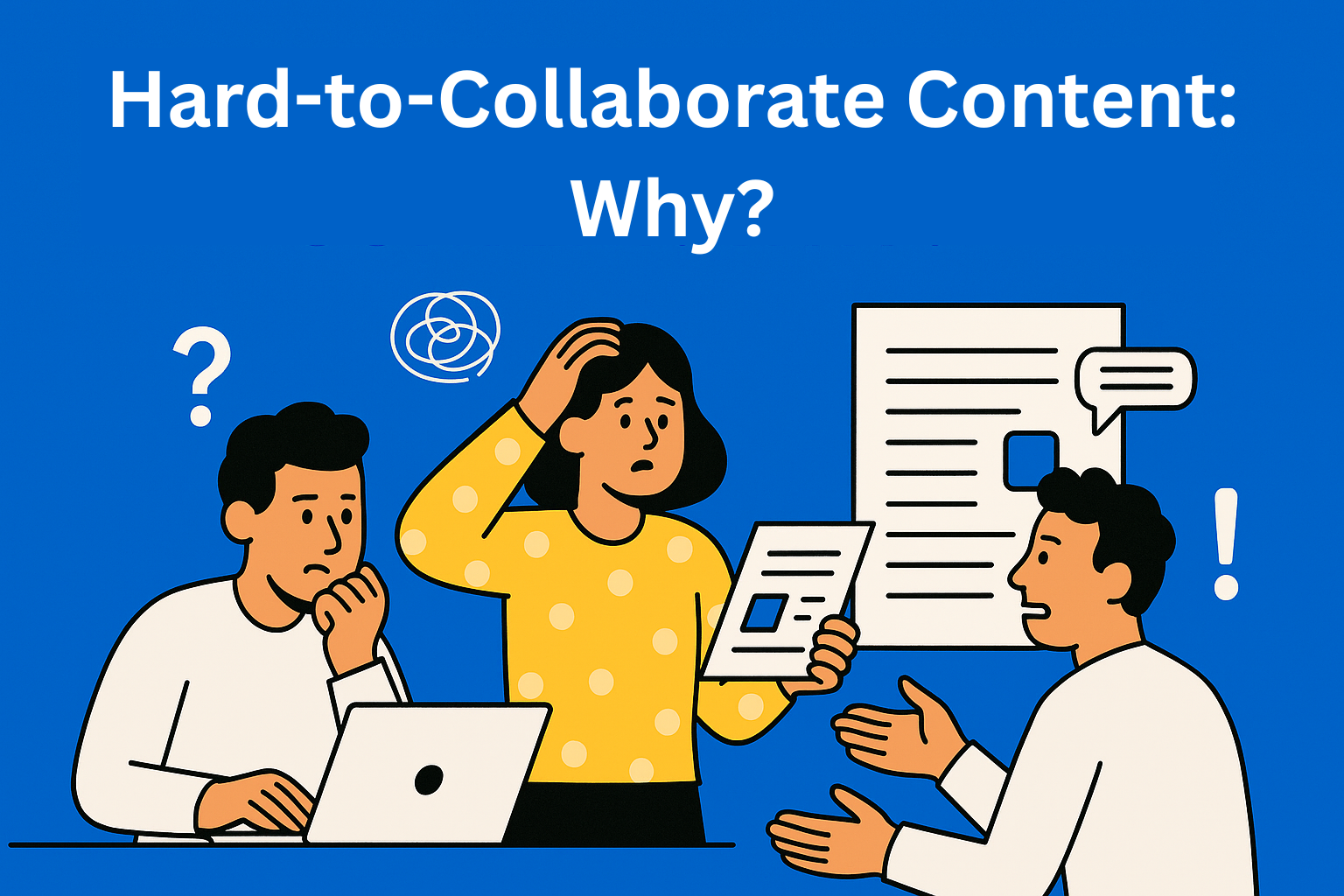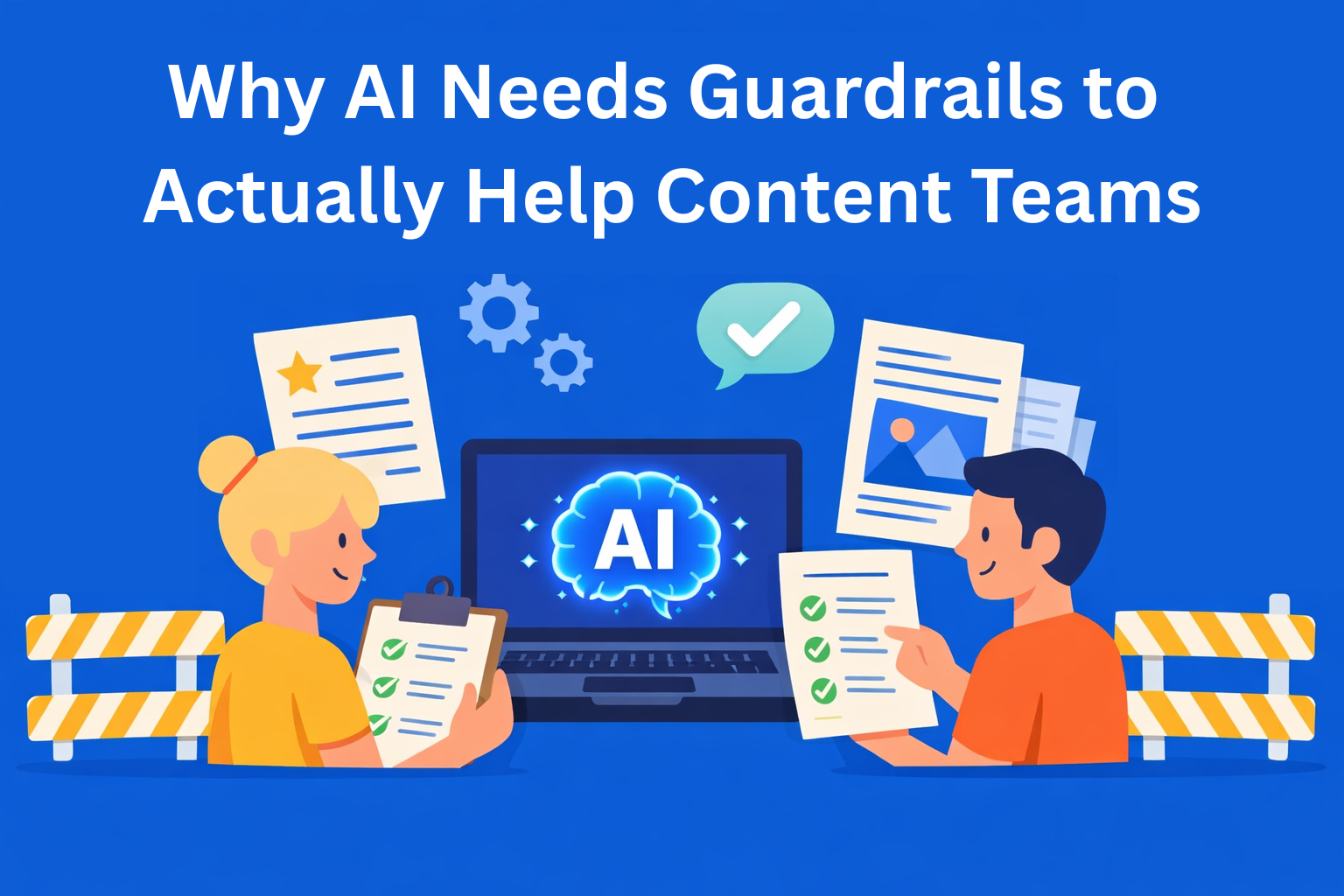What Makes Certain Content So Hard to Collaborate On?
Some content feels impossible to collaborate on and it’s not about the topic, but the process. Learn why content collaboration breaks down, how to spot the signs, and what tools can help your team work smoother, faster, and with less chaos.

Let's face it... Some types of content are just hard to collaborate on. The issue isn’t the topic - it’s that the process and team aren’t well organized.
In this blog, we’ll explore why it’s sometimes difficult to collaborate on content, how to recognize the signs, and what you can do to make it easier.
Key Takeaways
- Collaboration fails without clear roles - Define ownership from the start to avoid overlap, delays, and confusion.
- Changing briefs derail progress - Lock in the direction before drafting, or risk wasting effort on constant rewrites.
- Too many cooks = messy content - Limit feedback rounds and centralize comments to reduce chaos and conflicting opinions.
- Poor tools make good teamwork impossible - Use dedicated platforms like EasyContent to streamline writing, feedback, and approvals.
- Briefs and structure solve 80% of the problem - A clear, detailed brief and a consistent content template will save hours of editing.
When does content collaboration become a pain?
Some content simply doesn’t play well with teamwork. Here are a few examples:
- Monthly newsletters where marketing, product, and leadership each want to tweak the messaging
- Thought leadership blogs that go through endless rewrites because no one agrees on the tone
- Social videos that get five rounds of feedback from different stakeholders with no clear owner
- Whitepapers that bounce between legal, compliance, and design teams - each with their own priorities
- Website copy that gets stuck because product wants detail, marketing wants punch, and sales wants both
In these situations, collaboration turns into frustration.
Why is some content so hard to collaborate on?
1. Unclear roles and responsibilities
When everyone is doing everything, but no one has a clearly assigned task, problems arise. People end up stepping on each other's toes, no one knows who has finished what, and tasks get duplicated or forgotten. Eventually, everyone assumes someone else is handling it - but no one actually is.
2. Clashing styles and priorities
One team member wants to focus on SEO, another insists the writing sounds natural and friendly, while a third only cares about increasing sales. When everyone pulls in a different direction and there's no alignment from the start, miscommunication happens. Without a clear brief that brings all goals and styles together, the team ends up stuck in revisions and confusion.
3. Constantly changing goals or briefs
Picture this: You’ve started writing for one audience, and then someone from the team says, "Hey, we’ve changed the messaging. Add a new CTA. Oh, and now we’re targeting businesses instead of individuals." Suddenly, all your previous work is outdated. When goals and directions keep shifting mid-process, everyone gets dragged backward, time is wasted, and frustration grows.
4. Poor tools (or poor use of good tools)
If the team is sharing Word documents via email instead of working in a collaborative tool like EasyContent, things go south fast. Every new version must be sent manually, comments get lost, and multiple people might edit the same thing at once. In the end, no one knows which version is the latest, and the process takes far longer than it should.
5. Never-ending feedback
When content goes through dozens of comment rounds, everyone feels the need to add their input - whether it’s useful or not. Without someone to prioritize the feedback, everything becomes cluttered with opinions. No one knows what really needs fixing versus what’s just a suggestion. Everyone ends up frustrated, feeling unheard or ignored, and the content never really moves forward.
Signs your content collaboration isn’t working
- Multiple versions of the same document are floating around Slack or email
- Duplicate files
- Conflicting comments
- “It’s easier if I just do it myself” mindset
- Feedback that’s all over the place
- Deadlines slipping because “we’re still waiting on someone”
If any of these sound familiar - it’s probably time to fix your process.
How to make content collaboration easier
1. Start with a clear brief
A good brief saves hours of revision. It should include:
- The goal of the content
- Tone and style
- Deadline
- Keywords
- Who gives the final approval
2. Assign ownership clearly
Everyone should know their role. Who’s writing the draft? Who’s editing? Who makes the final call? If this isn’t clearly defined, confusion and delays are almost guaranteed. People repeat tasks, skip steps, or wait on each other unnecessarily. When roles are clear, the team runs much more smoothly.
3. Use the right tools for the job
Tools like EasyContent can seriously improve collaboration by making it easier for teams to work together in one organized space. Here’s what it offers:
- Real-time writing and editing - no more back-and-forth documents
- Clearly defined workflow stages, so everyone knows where content stands
- Specific roles and permissions - people see and do only what’s relevant to them
- Centralized comments and feedback - no digging through emails or chat threads
- Customizable templates to keep content structured and consistent
All of this helps eliminate the confusion that comes from using too many tools or document versions. Everything is in one place - clear, organized, and accessible to the whole team. If you’re working with multiple people or clients, this isn’t a luxury - it’s essential.
4. Centralize feedback
Agree on one person or one channel for handling feedback. That way, you avoid people leaving conflicting comments in different places. A single source for suggestions helps filter out the noise and focus on what’s truly important.
5. Set a limit on revision rounds
Don’t let content go through endless edits. Set a clear rule - for example, allow no more than two rounds of feedback per person. After that, the content lead or decision-maker finalizes it. This helps avoid constant backtracking and saves the whole team a lot of time.
Conclusion
Content that’s hard to collaborate on isn’t necessarily bad - it’s just trapped in a broken system. Once you understand why things are getting stuck, you can fix the process and make collaboration smooth instead of stressful.
So the next time content feels stuck - take a look at your process, not your people. That’s usually where the real issue hides.






